Chapter 14 of the NCERT Class 9 Maths textbook focuses on Statistics, introducing key concepts such as data collection, representation, and interpretation. The chapter covers methods for organizing data, including frequency distribution tables, and emphasizes the importance of graphical representations like bar graphs, histograms, and pie charts. Students learn how to calculate measures of central tendency, namely mean, median, and mode, which help summarize data sets effectively. The chapter also includes practical examples and exercises to reinforce understanding, enabling students to apply statistical methods to real-world problems.
NCERT Solutions of Class 9th Chapter 14 Statistics Exercise 14.1, 14.2, 14.3, 14.4
We try to teach you all Questions in easy way. We solve all chapter wise sums of maths textbook. In every chapter include NCERT solutions. For solutions of Exercise 14.1, 14.2, 14.3, 14.4 click on Tabs :
1. Give five examples of data that you can collect from your day-to-day life.
Solution:
Five examples from day-to-day life:
- Number of students in our class.
- Number of fans in our school.
- Electricity bills of our house for last two years.
- Election results obtained from television or newspapers.
- Literacy rate figures obtained from Educational Survey
2. Classify the data in Q.1 above as primary or secondary data.
Solution:
Primary data: when the information was collected by the investigator herself or himself with a definite objective in her or his mind, the data obtained is called primary data.
Primary data; (i), (ii) and (iii)
Secondary data; when the information was gathered from a source which already had the information stored, the data obtained is called secondary data
Secondary data; (iv) and (v)
1. The blood groups of 30 students of Class VIII are recorded as follows:
A, B, O, O, AB, O, A, O, B, A, O, B, A, O, O,
A, AB, O, A, A, O, O, AB, B, A, O, B, A, B, O.
Represent this data in the form of a frequency distribution table. Which is the most common, and which is the rarest, blood group among these students?
Solution:
Frequency is the number of students having the same blood group. The frequency is represented in the table or the frequency distribution table:
| Blood Group | Number of Students(Frequency) |
| A | 9 |
| B | 6 |
| O | 12 |
| AB | 3 |
| Total | 30 |
The most common Blood Group is the blood group with highest frequency: O
The rarest Blood Group is the blood group with lowest frequency: AB
2. The distance (in km) of 40 engineers from their residence to their place of work were found as follows:
5 3 10 20 25 11 13 7 12 31
19 10 12 17 18 11 32 17 16 2
7 9 7 8 3 5 12 15 18 3
12 14 2 9 6 15 15 7 6 12
Construct a grouped frequency distribution table with class size 5 for the data given above taking the first interval as 0-5 (5 not included). What main features do you observe from this tabular representation?
Solution:
Since the given data is very large, we construct a grouped frequency distribution table of class size 5. , class interval will be 0-5, 5-10, 10-15, 15-20 and so on. The data is represented in the grouped frequency distribution table as:
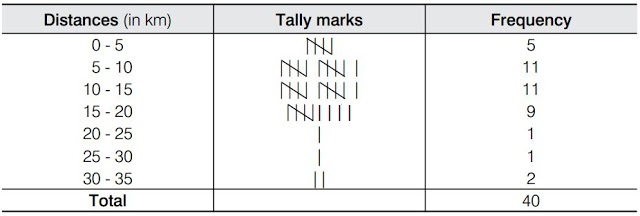
In the given table the classes do not overlap. Also we find that, the houses of 36 out of 40 engineers are below 20 km of distance
3. The relative humidity (in %) of a certain city for a month of 30 days was as follows:
98.1 98.6 99.2 90.3 86.5 95.3 92.9 96.3 94.2 95.1
89.2 92.3 97.1 93.5 92.7 95.1 97.2 93.3 95.2 97.3
96.2 92.1 84.9 90.2 95.7 98.3 97.3 96.1 92.1 89
(i) Construct a grouped frequency distribution table with classes 84 – 86, 86 – 88, etc.
(ii) Which month or season do you think this data is about?
(iii) What is the range of this data?
Solution:
(i) Since the given data is very large, we construct a grouped frequency distribution table of class size 2.
, class interval will be 84-86, 86-88, 88-90, 90-92 and so on. The data is represented in the grouped frequency distribution table as:
| Relative humidity (in %) | Frequency |
| 84-86 | 1 |
| 86-88 | 1 |
| 88-90 | 2 |
| 90-92 | 2 |
| 92-94 | 7 |
| 94-96 | 6 |
| 96-98 | 7 |
| 98-100 | 4 |
| Total | 30 |
(ii) The humidity is very high in the given data. Since the humidity is observed to be high during the rainy season, the data here must be about rainy season.
(iii) The range of a data = The maximum value of the data–minimum value of the data
= 99.2−84.9
= 14.3
4. The heights of 50 students, measured to the nearest centimeters, have been found to be as follows:
161 150 154 165 168 161 154 162 150 151
162 164 171 165 158 154 156 172 160 170
153 159 161 170 162 165 166 168 165 164
154 152 153 156 158 162 160 161 173 166
161 159 162 167 168 159 158 153 154 159
(i) Represent the data given above by a grouped frequency distribution table, taking the class intervals as 160 – 165, 165 – 170, etc.
(ii) What can you conclude about their heights from the table?
Solution:
(i) The data given in the question can be represented by a grouped frequency distribution table, taking the class intervals as 160 – 165, 165 – 170, etc., as:
| Height (in cm) | No. of Students(Frequency) |
| 150-155 | 12 |
| 155-160 | 9 |
| 160-165 | 14 |
| 165-170 | 10 |
| 170-175 | 5 |
| Total | 50 |
(ii) It can be concluded from the given data and the table that 35 students, i.e. more than 50% of the total students, are shorter than 165 cm.
5. A study was conducted to find out the concentration of sulphur dioxide in the air in parts per million (ppm) of a certain city. The data obtained for 30 days is as follows:
0.03 0.08 0.08 0.09 0.04 0.17
0.16 0.05 0.02 0.06 0.18 0.20
0.11 0.08 0.12 0.13 0.22 0.07
0.08 0.01 0.10 0.06 0.09 0.18
0.11 0.07 0.05 0.07 0.01 0.04
(i) Make a grouped frequency distribution table for this data with class intervals as 0.00 – 0.04, 0.04 – 0.08, and so on.
(ii) For how many days, was the concentration of Sulphur dioxide more than 0.11 parts per million?
Solution:
(i) The grouped frequency distribution table for the data given in the question with class intervals as 0.00 – 0.04, 0.04 – 0.08, and so on is given below.
| Concentration of sulphur dioxide in air(in ppm) | Frequency |
| 0.00 − 0.04 | 4 |
| 0.04 − 0.08 | 9 |
| 0.08 − 0.12 | 9 |
| 0.12 − 0.16 | 2 |
| 0.16 − 0.20 | 4 |
| 0.20 − 0.24 | 2 |
| Total | 30 |
(ii) The number of days in which the concentration of sulphur dioxide was more than 0.11 parts per million = 2+4+ 2 = 8
6. Three coins were tossed 30 times simultaneously. Each time the number of heads occurring was noted down as follows:
0 1 2 2 1 2 3 1 3 0
1 3 1 1 2 2 0 1 2 1
3 0 0 1 1 2 3 2 2 0
Prepare a frequency distribution table for the data given above.
Solution:
The frequency distribution table for the data given in the question is given below:
| Number of Heads | Frequency |
| 0 | 6 |
| 1 | 10 |
| 2 | 9 |
| 3 | 5 |
| Total | 30 |
7. The value of π up to 50 decimal places is given below:
3.14159265358979323846264338327950288419716939937510
(i) Make a frequency distribution of the digits from 0 to 9 after the decimal point.
(ii) What are the most and the least frequently occurring digits?
Solution:
(i) The frequency distribution of the digits from 0 to 9 after the decimal point is given in the table below:
| Digits | Frequency |
| 0 | 2 |
| 1 | 5 |
| 2 | 5 |
| 3 | 8 |
| 4 | 4 |
| 5 | 5 |
| 6 | 4 |
| 7 | 4 |
| 8 | 5 |
| 9 | 8 |
| Total | 30 |
(ii) The digit having the least frequency occurs the least. Since 0 occurs only twice, it has a frequency of 2. ,The least frequently occurring digit is 0.
The digit with highest frequency occurs the most. Since 3 and 9 occurs eight times, it has a frequency of 8. , The most frequently occurring digits are 3 and 9.
8. Thirty children were asked about the number of hours they watched TV programmes in the previous week. The results were found as follows:
1 6 2 3 5 12 5 8 4 8
10 3 4 12 2 8 15 1 17 6
3 2 8 5 9 6 8 7 14 12
(i) Make a grouped frequency distribution table for this data, taking class width 5 and one of the class intervals as 5-10.
(ii) How many children watched television for 15 or more hours a week?
Solution:
(i) The grouped frequency distribution table for the data given in the question, taking class width 5 and one of the class intervals as 5-10 is given below:
| Number of Hours | Frequency |
| 0-5 | 10 |
| 5-10 | 13 |
| 10-15 | 5 |
| 15-20 | 2 |
| Total | 30 |
(ii) From the given table, we can conclude that 2 children watched television for 15 or more hours in a week.
9. A company manufactures car batteries of a particular type. The lives (in years) of 40 such batteries were recorded as follows:
2.6 3.0 3.7 3.2 2.2 4.1 3.5 4.5
3.5 2.3 3.2 3.4 3.8 3.2 4.6 3.7
2.5 4.4 3.4 3.3 2.9 3.0 4.3 2.8
3.5 3.2 3.9 3.2 3.2 3.1 3.7 3.4
4.6 3.8 3.2 2.6 3.5 4.2 2.9 3.6
Construct a grouped frequency distribution table for this data, using class intervals of size 0.5 starting from the interval 2 – 2.5.
Solution:
The grouped frequency distribution table for the data given in the table, using class intervals of size 0.5 starting from the interval 2 – 2.5, is given below.
| Lives of batteries (in years) | No. of batteries(Frequency) |
| 2-2.5 | 2 |
| 2.5-3 | 6 |
| 3-3.5 | 14 |
| 3.5-4 | 11 |
| 4-4.5 | 4 |
| 4.5-5 | 3 |
| Total | 40 |
1. A survey conducted by an organisation for the cause of illness and death among the women between the ages 15 – 44 (in years) worldwide, found the following figures (in %):
| S.No. | Causes | Female fatality rate (%) |
| 1. | Reproductive health conditions | 31.8 |
| 2. | Neuropsychiatric conditions | 25.4 |
| 3. | Injuries | 12.4 |
| 4. | Cardiovascular conditions | 4.3 |
| 5. | Respiratory conditions | 4.1 |
| 6. | Other causes | 22.0 |
(i) Represent the information given above graphically.
(ii) Which condition is the major cause of women’s ill health and death worldwide?
(iii) Try to find out, with the help of your teacher, any two factors which play a major role in the cause in (ii) above being the major cause.
Solution:
(i) The information given in the question is represented below graphically.
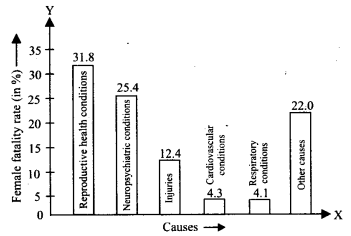
(ii) We can observe from the graph that reproductive health conditions is the major cause of women’s ill health and death worldwide.
(iii) Two factors responsible for cause in (ii) are:
- Lack of proper care and understanding.
- Lack of medical facilities.
2. The following data on the number of girls (to the nearest ten) per thousand boys in different sections of Indian society is given below.
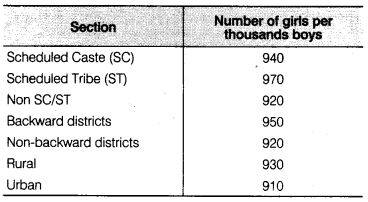
(i) Represent the information above by a bar graph.
(ii) In the classroom discuss what conclusions can be arrived at from the graph.
Solution:
(i) The information given in the question is represented below graphically.

ii) From the above graph, we can conclude that the maximum number of girls per thousand boys is present in the section ST. We can also observe that the backward districts and rural areas have more number of girls per thousand boys than non-backward districts and urban areas.
3. Given below are the seats won by different political parties in the polling outcome of a state assembly elections:

(i) Draw a bar graph to represent the polling results.
(ii) Which political party won the maximum number of seats?
Solution:
(i) The required bar graph is shown below:
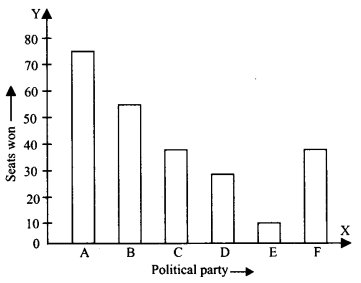
(ii) The political party A won the maximum number of seats.
4. The length of 40 leaves of a plant are measured correct to one millimeter, and the obtained data is represented in the following table:
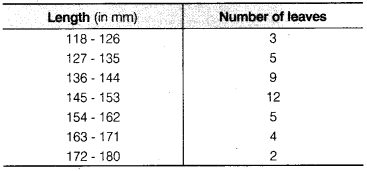
(i) Draw a histogram to represent the given data.
(ii) Is there any other suitable graphical representation for the same data?
(iii) Is it correct to conclude that the maximum number of leaves 153 mm long and Why?
Solution:
(i) The given frequency distribution table is not continuous. Therefore, first we have to modify it to be continuous distribution.
Thus, the modified frequency distribution table is:
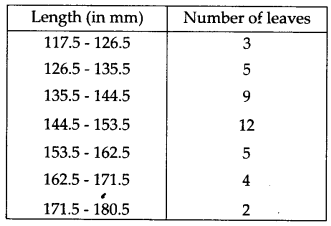
Now, the required histogram of the frequency distribution is shown below :
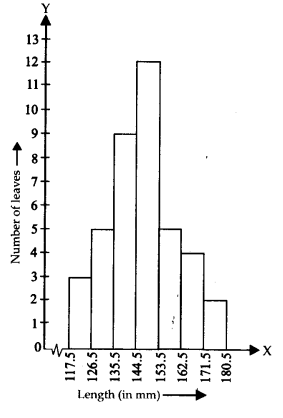
(ii) Yes, other suitable graphical representation is a ‘frequency polygon’.
(iii) No, it is not a correct statement. The maximum number of leaves lie in the class interval 145 – 153.
Question 5.
The following table gives the lifetimes of 400 neon lamps
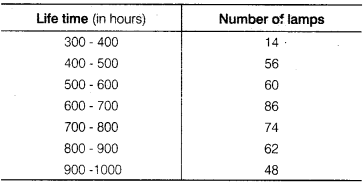
(i) Represent the given information with the help of a histogram.
(ii) How many lamps have a lifetime of more 700 h?
Solution:
(i) The required histogram is shown below:
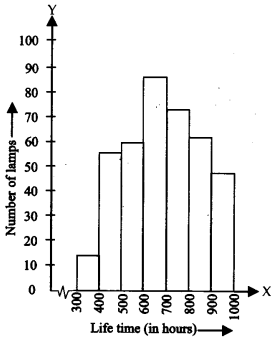
(ii) Number of lamps having life time of more than 700 hours = 74 + 62 + 48 = 184.
Question 6.
The following table gives the distribution of students of two sections according to the marks obtained by them

Represent the marks of the students of both the sections on the same graph by two frequency polygons. From the two polygons compare the performance of the two sections.
Solution:
To draw a frequency polygon, we mark the class marks along x-axis. Therefore, the modified table is:
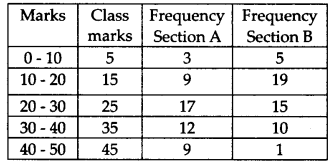
So, the two frequency polygons are as shown below:
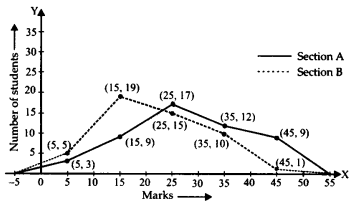
From the above frequency polygon, we can see that more students of section A have secured good
Question 7.
The runs scored by two teams A and B on the first 60 balls in a cricket match are given below
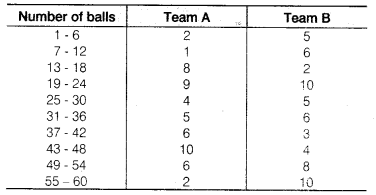
Represent the data of both the teams on the same graph by frequency polygons.
Solution:
The given class intervals are not continuous. Therefore, we first modify the distribution as continuous.
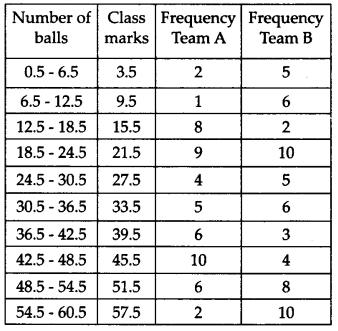
Now, the required frequency polygons are as shown below:
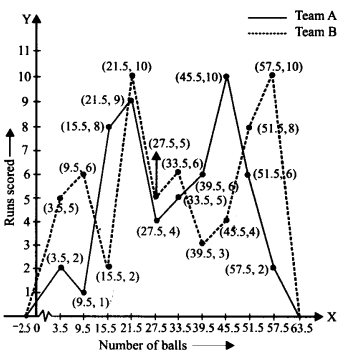
Question 8.
A random survey of the number of children of various age groups playing in a park was found as follows:
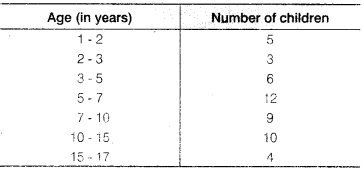
Draw a histogram to represent the data above.
Solution:
Here, the class sizes are different. So, we calculate the adjusted frequencies corresponding to each rectangle i.e., length of the rectangle.
Adjusted frequency or length of the rectangle

Here, the minimum class size = 2 – 1 = 1
∴ We have the following table for adjusted frequencies or length of rectangles:
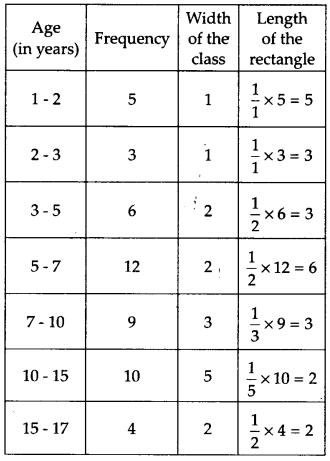
Now, the required histogram is shown below:
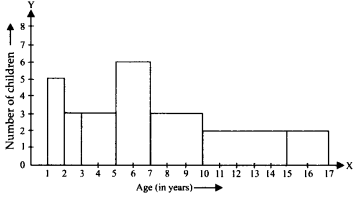
Question 9.
100 surnames were randomly picked up from a local telephone directory and a frequency distribution of the number of letters in the English alphabet in the surnames was found as follows
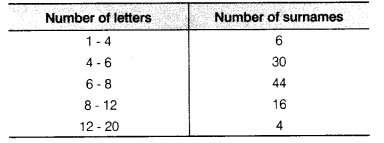
(i) Draw a histogram to depict the given information.
(ii) Write the class interval in which the maximum number of surnames lie.
Solution:
(i) Since, class intervals of the given frequency distribution are unequal, and the minimum class size = 6 – 4 = 2.
Therefore, we have the following table for length of rectangles.
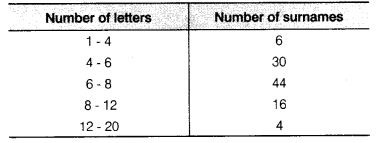
The required histogram is shown below:
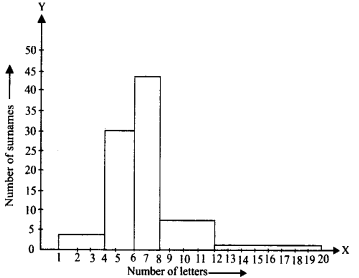
(ii) The maximum frequency is 44, which is corresponding to the class interval 6 – 8.
∴ Maximum number of surnames lie in the class interval 6 – 8.
1. The following number of goals were scored by a team in a series of 10 matches:
2, 3, 4, 5, 0, 1, 3, 3, 4, 3
Find the mean, median and mode of these scores.
Solution:
Mean = Average = Sum of all the observations/Total number of observations
= (2+3+4+5+0+1+3+3+4+3)/10
= 28/10
= 2.8
Median,
To find the median, we first arrange the data in ascending order.
0, 1, 2, 3, 3, 3, 3, 4, 4, 5
Here,
Number of observations (n) = 10
Since the number of observations are even, the median can be calculated as:
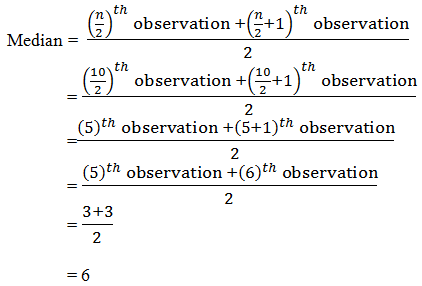
= 3
Mode,
To find the mode, we first arrange the data in ascending order.
0, 1, 2, 3, 3, 3, 3, 4, 4, 5.
Here,
We find that 3 occurs most frequently (4 times)
∴ Mode = 3
2. In a mathematics test given to 15 students, the following marks (out of 100) are recorded:
41, 39, 48, 52, 46, 62, 54, 40, 96, 52, 98, 40, 42, 52, 60
Find the mean, median and mode of this data.
Solution:
Mean=Average = Sum of all the observations/Total number of observations
= (41+39+48+52+46+62+54+40+96+52+98+40+42+52+60)/15
= 822/15
= 54.8
Median,
To find the median, we first arrange the data in ascending order.
39, 40, 40, 41, 42, 46, 48, 52, 52, 52, 54, 60, 62, 96, 98
Here,
Number of observations (n) = 15
Since the number of observations are odd, the median can be calculated as:
Median = [(n+1)/2]th observation
= [(15+1)/2]th observation
= (16/2)th observation
= 8th observation
= 52
Mode,
To find the mode, we first arrange the data in ascending order.
39, 40, 40, 41, 42, 46, 48, 52, 52, 52, 54, 60, 62, 96, 98
Here,
We find that 52 occurs most frequently (3 times)
∴ Mode = 52
3. The following observations have been arranged in ascending order. If the median of the data is 63, find the value of x.
29, 32, 48, 50, x, x+2, 72, 78, 84, 95
Solution:
Number of observations (n) = 10
Given that Median = 63
Since the number of observations are even, the median can be calculated as:

63 = [5th observation+(5+1)th observation]/2
63 = [5th observation+6th observation]/2
63 = (x+x+2)/2
63 = (2x+2)/2
x = 63-1
x = 62
4. Find the mode of 14, 25, 14, 28, 18, 17, 18, 14, 23, 22, 14, 18.
Solution:
Mode,
To find the mode, we first arrange the given data in ascending order.
14,14,14,14,17,18,18,18,22,23,25,28
Here,
We find that 14 occurs most frequently (4 times)
∴ Mode = 14
5. Find the mean salary of 60 workers of a factory from the following table:
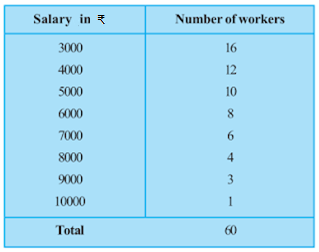
Solution:
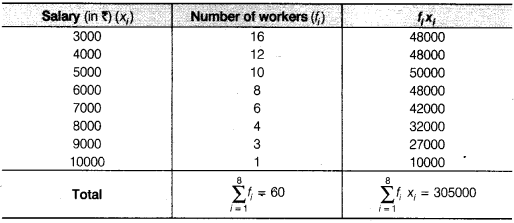
Thus, the required mean salary = Rs. 5083.33
Question 6.
Give one example of a situation in which
(i) the mean is an appropriate measure of central tendency.
(ii) the mean is not an appropriate measure of central tendency but the median is an appropriate measure of central tendency.
Solution:
(i) Mean height of the students of a class.
(ii) Median weight of a pen, a book, a rubber band, a match box and a chair.
